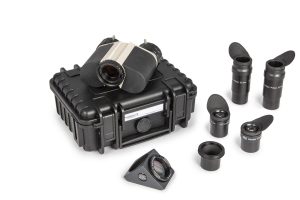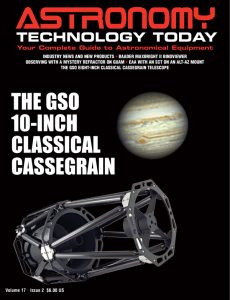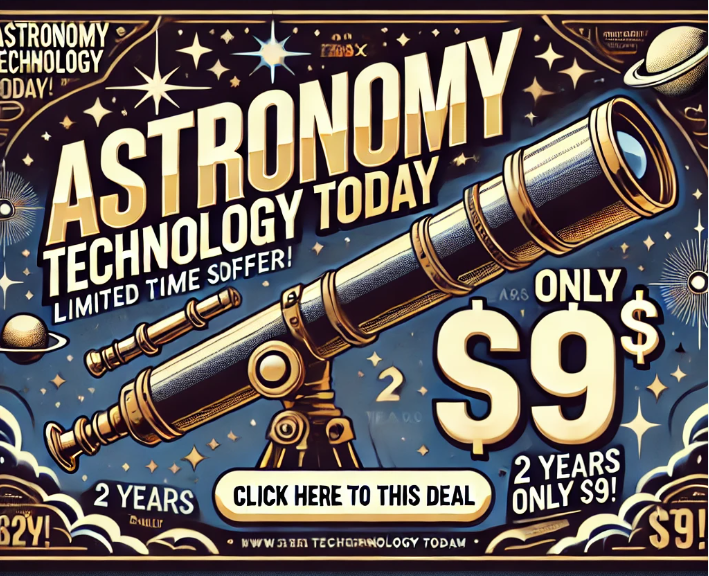The new Baader MaxBright II Eyepiece Sets are a new option when buying the MaxBright II binoviewer and include two Classic Baader Ortho or Plössl eyepieces designed to mate perfectly with the Baader MaxBright II.
 The following Baader MaxBright II Eyepiece Sets are available:
The following Baader MaxBright II Eyepiece Sets are available:
– MaxBright II with two 6mm Classic Ortho eyepieces.
– MaxBright II with two 10mm Classic Ortho eyepieces.
– MaxBright II with two 18mm Classic Ortho eyepieces.
– MaxBright II with two 32mm Classic Plössl eyepieces.
These new Baader MaxBright II Eyepiece Sets make it even more convenient to own the high-end MaxBright II binoviewer which was conceived as a more compact and lighter option to Baader’s flagship Mark V Großfeld (Giant)-Binocular, now in its fifth edition of the former Carl Zeiss giant binocular with 30 mm prisms. The MaxBright II was designed to offer all of the advanced features and build quality of the V Großfeld.
The housing of the MaxBright II’s 27mm large prisms is made with Baader’s in house die casting molds, using Carl Zeiss production drawings. The non-slip leather finish provides extra grip when holding the binoviewer with heavy eyepieces in your hand.
On the eyepiece side, the self-centering Clicklock eyepiece clamps with diopter adjustment offer an ease of functionality that is immediately noticeable upon using. Thanks to the ergonomic design, you can blindly distinguish between clamping and diopter compensation even in the dark. The inner parts are made of stainless steel for maximum stability and the high-quality eyepiece clamps are part of a precisely collimated optical system, which is designed for the highest magnifications.
All optical surfaces of the Maxbright II feature a 7-layer multi-coating. The prism chairs (mounts) of the prisms are constructed like those of the Baader Mark V Großfeld (Giant)-Binocular. The clear aperture is 26 mm on the telescope side and 25.5mm on the eyepiece side. In comparison to models with smaller prisms you can see a much larger part of the sky at the same magnification.
On the telescope side, either a T-2 cap nut or a dovetail ring with original Zeiss micro bayonet are available – both connection options are included and allow a very compact adaptation to all common threads as well as Baader T-2 prisms and mirrors. Compared to fixed nosepieces, this effectively saves a lot of backfocus.
The MaxBright II is compatible with all Baader Glasspathcorrectors. According to optical calculations by Carl Zeiss, these correction lens systems shift the focus outwards so that you can still reach focus despite the approximately 11 cm back focus (the required inward travel of the focuser) of the binoviewer. The Glasspathcorrectors also compensate for the color error that would otherwise be introduced through the prisms when using telescopes between f/4 and f/7. Glasspathcorrectors are not simple Barlow lenses, even if they resemble them. For this reason, in Germany the name Glaswegkorrektor is a protected trademark by Baader Planetarium.
You don’t necessarily need a Glasspathcorrector for Schmidt-Cassegrains with f/10. Especially for lower magnifications and thus larger fields of view, Baader’s Alan Gee Telecompressor Mark II (T-2 part #20) is more interesting as it shortens the focal ratio to f/5,9, which gives you a brighter image and a larger field of view. So, a C8 almost becomes a rich-field telescope – for comfortable observations with both eyes open.
You can learn more about the Baader MaxBright II Eyepiece Sets here.

 And to make it easier for you to get the most extensive news, articles and reviews that are only available in the magazine pages of Astronomy Technology Today, we are offering a 1-year magazine subscription for only $6! Or, for an even better deal, we are offering 2 years for only $9. Click here to get these deals which only will be available for a very limited time. You can also check out a free sample issue here.
And to make it easier for you to get the most extensive news, articles and reviews that are only available in the magazine pages of Astronomy Technology Today, we are offering a 1-year magazine subscription for only $6! Or, for an even better deal, we are offering 2 years for only $9. Click here to get these deals which only will be available for a very limited time. You can also check out a free sample issue here.
The Sun is more active than it’s been in years and if that’s not enough, we have the Annular Solar Eclipse on October 14, 2023 and the Total Solar Eclipse on April 8, 2024! If you’d like to learn more about the technology behind solar observing, solar imaging and more, you can check out our new monthly magazine – Solar Astronomy Today. It’s free to read, no subscription needed and available here. And if you are preparing for the upcoming eclipses and want to know your equipment options from solar glasses to the most out of this world solar viewing and imaging options, check out our free publication – The Definitive Guide to Viewing and Imaging the Sun – simply click here and enjoy reading!



